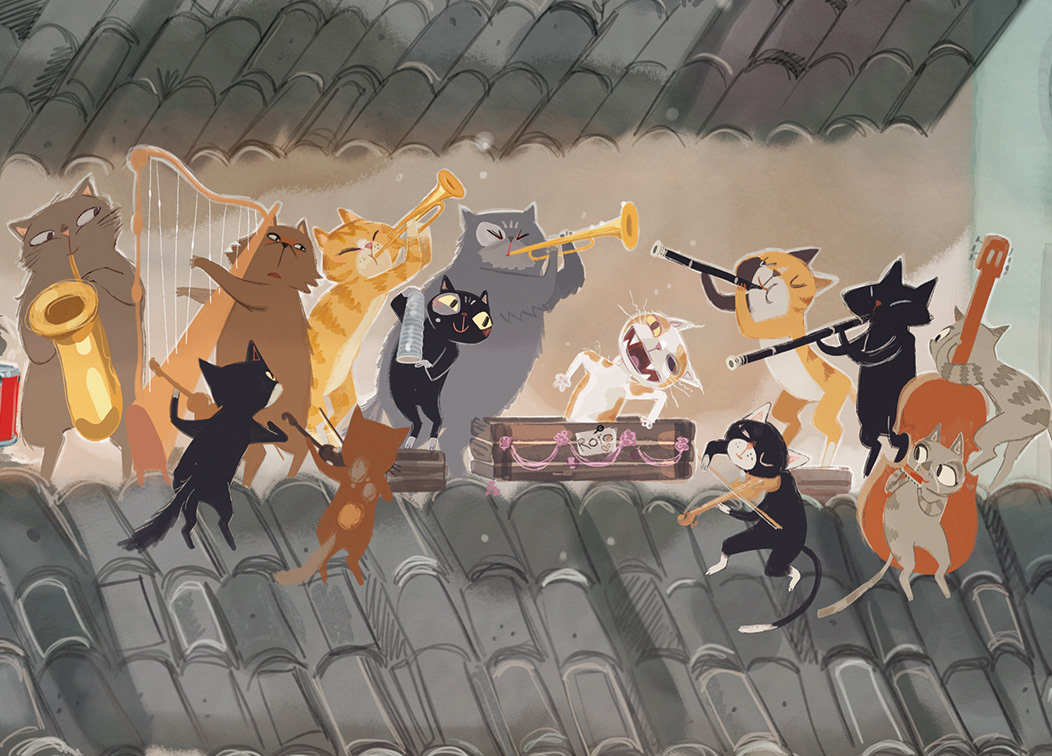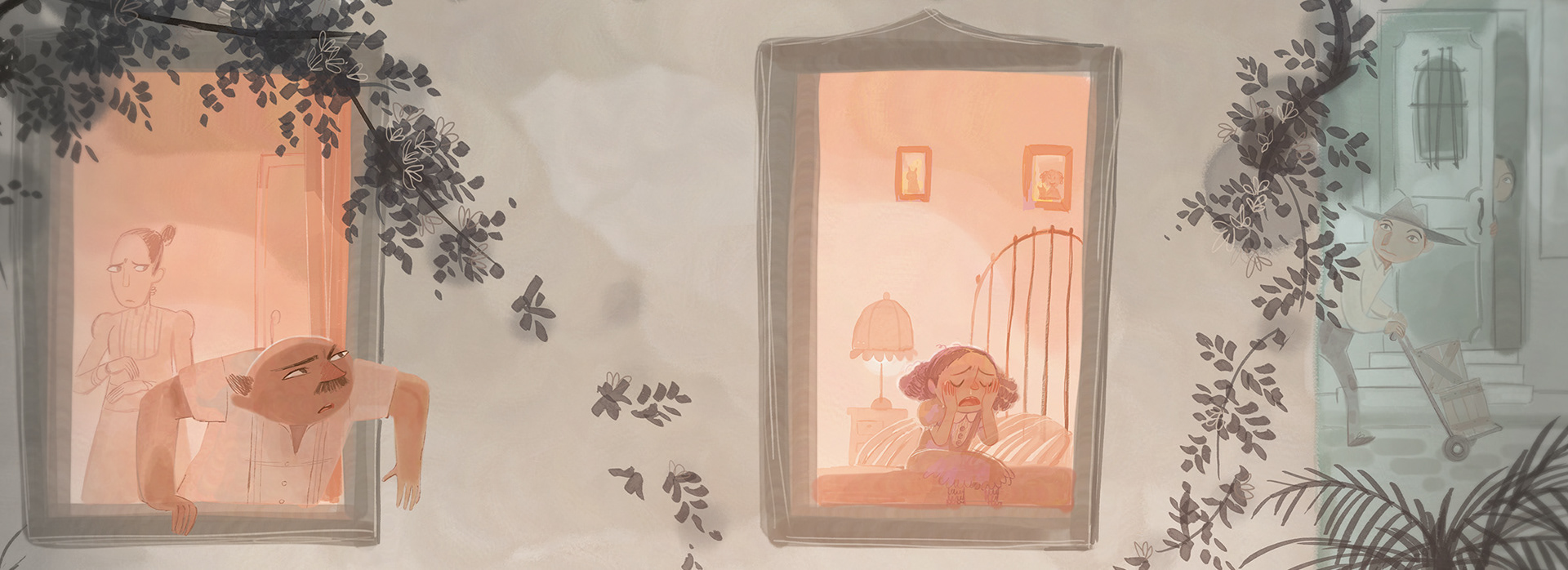History of British children's book illustration
How to be a children's book illustrator
Interview with Illustrator Aymen
11 beloved children's book illustrators
Children's book illustration with Teresa Martínez
Children's illustration report
q & a
Home
This is ------->
Take me to:
Children's book illustration | Teresa Martínez
Teresa Martínez is an illustrator based in Puerto, Vallarta in Mexico. She grew up in a small town, and lived an idyllic life. Later when Teresa moved to a bigger city with her family, she became very shy and found a way of expressing her self to other children through drawings.
Teresa have been working in the publishing industry for more than 15 years, she first worked as a graphic designer, and learned traditional techniques in like acrylics oil and watercolour in Italy, later she became an illustrator because the thought of wanting to convey a message through image.
Since 2002, Teresa has worked with textbook illustrations, as well as small illustration of stories. Teresa’s work was noticed by the editor of Mexican children’s illustrators, and offered her the opportunity to work on the book of “Mexican Fables”, within working she received a lot of the important tips and guides in children’s book illustrations, from Rebeca Cerda. Teresa continued with her illustration career with different publishers, and exceed in honourable mentions.
It’s often to have new ideas constantly forming whilst following the story board.
Influences:
Alfons Mucha’s use of lines and compositions.
The repetitive patterns and striking texture in Klimt’s work, Teresa also incorporates this in her work.
Comics and cartons: Rumiko Takahashi, Miyazaki, Calvin and Hobbes comics.
Website:
www.teresa-mtz.com
Online course on Domestika:
https://www.domestika.org/en/teresa_mtz
Behance:
https://www.behance.net/teresamtz
Astound:
www.astound.us
Los Elegantes, la niña y el pajaro cucu, 2017
"Los Elegantes" pirates and a magical girl.
1. After receiving the manuscript from the editor, Teresa would print out the text and start reading the novel.
Taking notes on the side, underlining all the important details to be reflected in the illustration.
2. Teresa reads the text for the second time, she begin making simple sketches and doodles, letting ideas form around the composition, characters and considering how the lightings and the shadow would be.
Illustration can be important when it tells the story totally different from the text received from the editor. Narrative complement: an image can provides extra information that are not included in the text, a scene is incomplete with text solely, the image complement with the text to tell the story.
Making a book illustration with Teresa Martínez:
Composition is the way we distribute our element inside the canvas and the key to captivate the child’s attention.
When we have a dot in…
The centre of the canvas- Prominence, stability.
The bottom of the canvas- Feeling of falling, heavy and fixed on a base.
The top of the canvas- Feeling that it’s floating and elevated.
The edge of the canvas- Entering the scene.
The side of the canvas- Leaving the scene.
Two dots on the canvas- Interaction, approaching or moving away from each other.
Several dots on the canvas- Our eyes will start to group them in someway, linking and suggesting the sense of prominence.
Interpreting the text:
Composition:
The contour/ outline of the characters are equally important, to be clear and not confuse the readers.
Compositions of the background should be structured carefully, the characters should stand out from the scene. Play around with the shape and horizon of the image to make the composition more free and less stiff.
Character outline sketches by Teresa Martínez
The page number of children’s story book, are usually in the multiples of eight, commonly 32 pages, sometimes are 24 and 16 pages for younger children.
It’s important to note that nothing important goes in the gutter- that is the the middle where pages bind together- of the book.
Splash page is the use of two full pages to make a big scene, within the image there should be some elements that frame the scene and maintain good balance.
Text fonts are very important when composing book illustrations, sometimes the editor will provide you with the accommodated font and you have to incorporate with your illustration.
It’s possible to spend hours or days just sketching out on the story board, in order to decide what works out the best.
Story board:
The first and the last page are the end paper.
Page 2,3, 30,31 are also the end paper of the book.
Page 4, are usually the credits, legal information or the dedications.
Page 5 is for the title, welcoming the readers to your book.
12 Pages remaining for the story
Creating the illustration:
This stage is where all the creative process of a book happens.
After you have completed the thumbnail drawings on your story boards, it's time to paint them on a bigger canvas.
Things to consider when painting the scene: highlight, shadows, composition, mood, texture and movements.
Teresa's tip on losing the fear of the blank sheet:
The key is to form a quick sketch first, the composition consists of only fast lines and doodles, forming a miniature for the story board, then gradually adding more details, re-arranging elements and adding the greys, step by step.
After finessing the details for the sketch layer, you should consider the contrast as part of you composition, before moving on to the colour, it’s helpful to study the B&W values first.
On Colour palette:
In general, you only have to chose few colours to work with. Knowing that red, yellow and blue is primary colours, we can mix these to form new colours- the hue.
Neutral tones including black, are towards greys with less saturation, they combine very well with other colours to create a harmony and balance in your painting.
It’s often for a beginner to use almost every pigment in their colour palette, in contrast with those who are more experienced, tends to use two or three colours at the beginning when they are painting, which resulted in the colours being very harmonious with an atmosphere.


- Adding extra details
- Small adjustments
- Make corrections
- Adding mock up titles and logos to the book…and other details
- Using the curve tool to make modifications to the lighting and colour of the final illustration
Final touch ups:
When you are presenting your project to your editor you should include:
- The illustration
- Your draft
- Story board / mock up of the book
- Simulated text (title, description, logos etc )
You don’t need to have the whole of the illustration to show to the editor yet, just include one or two illustrations that represent the tone of the story with a mock alongside, waiting to be reviewed. The next stage would be making adjustment and changes depending on the feedbacks received, this process repeats till you finish the entire book.
Introducing the project:
“Publishing a book is not immediate or simple, many times the route to achieve it requires some time, especially if you are a young artist and you’re starting”
As a beginner the first commission you will receive is probably projects to illustrate a single illustration or vignettes for textbooks and magazines or books, that is all good to build your portfolio.
Fabulas Mexicanas, 2009
Gato Muerto, 2019
(Dead Cat)
Find Teresa Martínez works on:
The following notes are taken from Teresa's online course on Domestika
Children's book illustration with Nia Thandapani